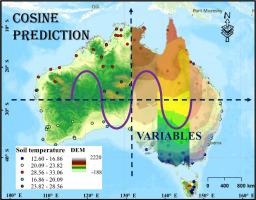Catena ( IF 5.4 ) Pub Date : 2021-09-11 , DOI: 10.1016/j.catena.2021.105696 Tianpeng Zhang , Jr-Chuan Huang , Qiuliang Lei , Xia Liang , Stuart Lindsey , Jiafa Luo , A-Xing Zhu , Wankui Bao , Hongbin Liu

|
Soil temperature is a key parameter affecting changes in the balance among energy flow, water flow, nutrient cycling, and ecological stability. In previous research on soil temperature estimation, field measurement has been valuable. However its value is uncertain for regional scale research. A regression equation algorithm approach introduces the environmental factors into consideration. The correlations between soil temperature and environmental covariates may not be linear, and most of them conform to a parabolic relationship. Therefore, based on 53 years' data (1958-2010) from 140 meteorological stations in Australia, this study applied a 3-parameter cosine wave model to fit the monthly air and soil temperature. Further, this study identified the correlations between the parameters and landscape factors using stepwise regression. The root mean square error (RMSE) and Nash-Sutcliffe efficiency coefficient (NS) were used to evaluate the accuracy of the model. The results showed that: (1) The cosine-wave function can effectively identify the monthly air/soil temperature fluctuation and the prediction accuracy increases gradually from north to south in Australia. (2) The precipitation, horizontal irradiation and elevation are predominant factors that affecting soil temperature fluctuation given a defined air temperature fluctuation. (3) Landscape factors regulate the hysteresis of air/soil temperature fluctuation. The hysteresis of soil temperature response to air temperature in Australia is in order of duration: central > south > north. Therefore, the application of the cosine function is a useful and novel technique for estimation of soil temperature, which could provide better understanding of how soil temperature fluctuation responds to the global warming.
中文翻译:

澳大利亚土壤温度的实证估计及其控制因素:地理环境与气温相互作用的意义
土壤温度是影响能量流、水流、养分循环和生态稳定性之间平衡变化的关键参数。在以往的土壤温度估算研究中,现场测量一直很有价值。然而,它对区域尺度研究的价值是不确定的。回归方程算法方法引入了环境因素。土壤温度与环境协变量之间的相关性可能不是线性的,大部分符合抛物线关系。因此,本研究基于澳大利亚140个气象站53年(1958-2010)数据,采用3参数余弦波模型拟合月气温和土壤温度。此外,本研究使用逐步回归确定了参数与景观因素之间的相关性。均方根误差 (RMSE) 和 Nash-Sutcliffe 效率系数 (NS) 用于评估模型的准确性。结果表明:(1)余弦波函数可以有效识别澳大利亚的月空气/土壤温度波动,预测精度从北向南逐渐提高。(2)给定的气温波动,降水、水平辐照和海拔是影响土壤温度波动的主要因素。(3) 景观因素调节空气/土壤温度波动的滞后性。澳大利亚土壤温度对气温的滞后响应时间顺序为:中部>南部>北部。因此,余弦函数的应用是估计土壤温度的有用且新颖的技术,











































 京公网安备 11010802027423号
京公网安备 11010802027423号